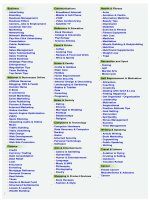Money and Banking: Lecture 22
Bạn đang xem bản rút gọn của tài liệu. Xem và tải ngay bản đầy đủ của tài liệu tại đây (184.23 KB, 31 trang )
Money and
Banking
Lecture 22
Review of the Previous Lecture
•
Role of Financial Intermediaries
•
•
Pool Savings
Safekeeping, accounting services and
access to the payments system;
Topics under Discussion
• Role of Financial Intermediaries (cont.)
• Liquidity;
• Risk diversification
• Information Services
• Information Asymmetry and Information
Costs
• Adverse Selection
• Moral Hazards
Providing Liquidity
• Liquidity is a measure of the ease and
cost with which an asset can be turned
into a means of payment
• Financial intermediaries offer us the ability
to transform assets into money at
relatively low cost (ATMs are an example)
Providing Liquidity
• Financial intermediaries provide liquidity in a
way that is efficient and beneficial to all of us
• By collecting funds from a large number of small
investors, a bank can reduce the cost of their
combined investment, offering the individual
investor both liquidity and high rates of return
• Financial intermediaries offer depositors something
they can’t get from financial markets on their own
• Financial intermediaries offer both individuals and
businesses lines of credit, which are pre-approved
loans that can be drawn on whenever a customer
needs funds
Diversifying Risk
• Financial intermediaries enable us to
diversify our investments and reduce risk
• While investing, don’t put all your eggs in
one basket
• Putting $1 in 100 stocks is better than
investing $100 in just one stock
• Financial institutions enable us to diversify our
investment and reduce risk.
Diversifying Risk
• Banks mitigate risk by taking deposits from a
large number of individuals and make
thousands of loans with them, thus giving each
depositor a small stake in each of the loans
• Bank may collect $1,000 from each of one million
depositors and then use $1 billion to make 10,000
loans of $100,000 each
• Thus each has a 1/1,000,000 share in each of the
10,000 loans. This is diversification!
• And since bank are expert at this game, it can
minimize the cost of all such transactions
Diversifying Risk
• All financial intermediaries provide a lowcost way for individuals to diversify their
investments
• Mutual funds
Information Services
• One of the biggest problems individual savers
face is figuring out which potential borrowers
are trustworthy and which are not
• There is an information asymmetry because the
borrower knows whether or not he or she is
trustworthy, but the lender faces substantial
costs to obtain the same information
Information Services
• Financial intermediaries reduce the
problems created by information
asymmetries by collecting and processing
standardized information
• Screen loan applications to guarantee the
creditworthiness
• Monitor loan recipients to ensure proper
usage of funds
A Summary of the Role of
Financial Intermediaries
•Pooling Savings:
•Accepting resources from a large number of
small savers/lenders in order to provide large
loans to borrowers.
•Safekeeping and Accounting:
•Keeping depositors’ savings safe, giving them
access to the payments system, and providing
them with accounting statements that help them
to track their income and expenditures.
A Summary of the Role of
Financial Intermediaries
• Providing Liquidity:
• Allowing depositors to transform their financial
assets into money quickly, easily, and at low
cost.
• Risk sharing:
• Providing investors with the ability to diversify
even small investments.
• Information Services:
• Collecting and processing large amounts of
standardized financial information.
Information Asymmetries and
Information Costs
• Information plays a central role in the
structure of financial markets and financial
institutions
• Markets require sophisticated information
in order to work well, and when the cost of
obtaining information is too high, markets
cease to function
Information Asymmetries and
Information Costs
• Asymmetric information
• issuers of financial instruments – borrowers
who want to issue bonds and firms that want
to issue stock – know much more about their
business prospects and their willingness to
work than potential lenders or investors
• solving this problem is one key to making our
financial system work as well as it does
Information Asymmetries and
Information Costs
• Lets take up our online store example
• Buyers must believe that item has been
described accurately and they must be sure that
the seller will send the item in exchange for their
payment
• Here sellers have much more information than
buyers have, creating an information asymmetry
• To resolve this issue,
• Induct an insurance system
• Devise an information system collecting data of
purchases and delivery
Information Asymmetries and
Information Costs
• Asymmetric information poses two
obstacles to the smooth flow of funds from
savers to investors:
• Adverse selection, - involves being able to
distinguish good credit risks from bad before
the transaction;
• Moral hazard, - arises after the transaction
and involves finding out whether borrowers
will use the proceeds of a loan as they claim
they will
Adverse Selection
• Potential borrowers know more about the
projects they wish to finance than prospective
lenders
• Used Cars and the Market for Lemons:
• In a market in which there are good cars (“peaches”) and
bad cars (“lemons”) for sale, buyers are willing to pay only
the average value of all the cars in the market.
• This is less than the sellers of the “peaches” want, so
those cars disappear from the markets and only the
“lemons” are left
Adverse Selection
• To solve this problem caused by asymmetric
information, companies like Consumer Reports
provide information about the reliability and safety
of different models, and car dealers will certify the
used cars they sell
Adverse Selection
• Adverse Selection in Financial Markets:
• Information asymmetries can drive good stocks and
bonds out of the financial market
• If you can’t tell the difference between a firm with a
good prospects and a firm with bad prospects, you
will be willing to pay a price based only on their
average qualities
• The stocks of the good company will be
undervalued so the mangers of these companies
will keep the stocks away from the market
• This leaves only the firms with bad prospects in the
market
Adverse Selection
• Adverse Selection in Financial Markets:
• The same happens in the bond market
• If a lender can not tell whether a borrower is a good
or a bad credit risk, the demand for a risk premium
will be based on the average risk
• Borrowers having good credit risk will not pay
higher risk premiums and would withdraw from the
market
• Only bad credit risk bonds are left in the market
Adverse Selection
• Solving the Adverse Selection Problem
• The adverse selection problem resulting in
good investments not to be undertaken, the
economy will not grow as rapidly as it could.
• So there must be some way of distinguishing
good firms from the bad ones
• Disclosure of Information
• Collateral and Net Worth
Adverse Selection
• Solving the Adverse Selection Problem
• Disclosure of Information:
• Generating more information is one obvious way to
solve the problem created by asymmetric information
• This can be done through government required
disclosure and the private collection and production
of information
• e.g. Securities and Exchange Commission regulations
• Reports from private sources such as rating
agencies, brokerage companies and financial
analysts
• The cost and credibility of such information are to be kept in
mind
Adverse Selection
• Solving the Adverse Selection Problem
• Collateral and Net Worth
• Collateral is something of a value pledged by a
borrower to the lender in the event of borrower’s
default
• Lenders can be compensated even if borrowers
default, and if the loan is so insured then the
borrower is not a bad credit risk
Adverse Selection
• Solving the Adverse Selection Problem
• Collateral and Net Worth
• Net worth is the owner’s stake in the firm, the value
of the firm minus the vale of its liabilities
• If a firm defaults on loan, the lender can make a
claim against the firm’s net worth
• The same is true for home loans
• The importance of net worth in reducing adverse
selection is the reason owners of new businesses
have so much difficulty borrowing money
Moral Hazards
• Moral hazard arises when we cannot
observe people’s actions, and so cannot
judge whether a poor outcome was
intentional or just a result of bad luck









